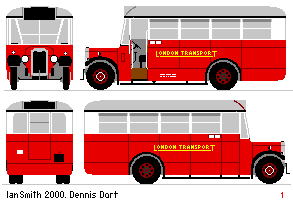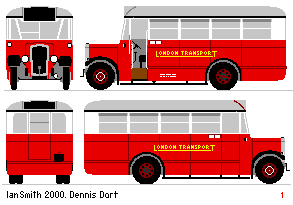
The LONDON TRANSPORT Dennis Darts
This page created 12th November 2000, updated 5th May 2003 using Notepad, by Ian Smith.|
Livery was red with white window surrounds, black mudguards and trim,
and a silver roof.
Into serviceDA 1-20: The first Darts appeared in LGOC service in the eight months from April 1930. DA1 went to Hounslow, probably for training, then joined five more at Hanwell in June for Uxbridge services 505 and 506. These had been operated by K-type single-deckers. A new 507 route was started in September when enough buses were available.
Harrow Weald, HD, used the type to displace S single deckers from the 353, and also for a new route, the 210A. Romford, a fruitful area for Dart deployment by several independents, received a LGOC example for new G3 in December 1933.
The effect of the new buses was route development:
DA 33-40: Eight more 18-seater Darts, were ordered in 1932, with a revised internal layout: two triple seats facing inwards at the front, and three rows of forward facing seats behind. They must have been cosy!. They appeared between December 1932 and February 1933, displacing older Darts which went to Kingston, K, to start new route 198, and to Harrow Weald, HD, for new route 230. DA 41-42: The final two LGOC Darts were even narrower. They had 17-seater bodies, just 6ft 6in wide, with a 9-seater offside bench and an 8-seater nearside bench. These were for the 211, operated by Hanwell, HW. DA 43-45: Three Darts with lower better-looking bodies by Metcalfe were acquired by London Transport in 1934 with the takeover of the Romford & District Bus Company. Initially they continued to be used on the 252B, first at Barking (BK) and then Hornchurch (RD) until the route ceased in December 1936. Then they moved to Enfield for the 205 (Chingford - Potters Bar - Cuffley).
Class declineAs the thirties progressed, these little petrol buses wore out: six or seven years was a normal bus-life in those days. Their duties were progressively taken over by larger buses as London grew, and by 1939 London Transport had a surplus of small buses. All the minor types had gone, leaving just the Cubs, the Darts and a few Bedfords. The Darts and Bedfords, with petrol engines, were marked for replacement, which came in the form of the rear-engined CR class. Although the CRs were late arriving, the mass withdrawal of the Darts was precipitated by the start of the Second World War. Eighteen seater petrol-engined buses were just not viable. They went into store, many at Chiswick Tram Depot, and were all sold in early 1940. They went for a variety of uses, their capacious bodies making them useful as first aid posts and local command vehicles. After the war some became showman's buses and farm vehicles. None is known to survive.
|
 London General bought Dennis Darts in 1930 for the some of the same reasons
that London Buses bought them in
London General bought Dennis Darts in 1930 for the some of the same reasons
that London Buses bought them in  DA 21-32: The next batch, in 1931,
had modified bodywork, with body-mounted sidelights,
front screens at the same level as the other windows,
a deeper radiator and a deeper destination box.
They replaced older Darts that were coming in for overhaul:
DA21 started off as the Chiswicks works float to enable body-swapping at overhaul
DA 21-32: The next batch, in 1931,
had modified bodywork, with body-mounted sidelights,
front screens at the same level as the other windows,
a deeper radiator and a deeper destination box.
They replaced older Darts that were coming in for overhaul:
DA21 started off as the Chiswicks works float to enable body-swapping at overhaul
 Ian's Bus Stop
Ian's Bus Stop Dart main text.
Dart main text. Dart histories
Dart histories